I had a completely different post planned for today. Then this morning, between rain showers, I went on a walk along one of the creeks on the property, and found a colony of these dainty little wild violets growing in the shade.
Viola glabella, also known as Stream Violet, Pioneer Violet, or Smooth Yellow Violet, is a common perennial violet. This species is found in moist woodlands along the coast ranges in western North America and northeastern Asia, generally below 6500 ft.
Earlier this spring we found another native violet on the property, Viola ocellata, which seems more sun-tolerant than the Stream Violet. Viola glabella favors very moist woodland shade, and I only found it in one area near the creek, beneath a canopy of mature Redwoods, Fir and Bay Laurel.
Viola glabella grows 4-8 inches tall, and reportedly favors damp nitrogen rich soils in sites that periodically are subject to flooding. No doubt this lovely little plant is enjoying this week’s rain!
The flowers of Viola glabella emerge on slender stalks, and the petals are yellow on both sides, with the exception of the purple veined nectar guides on the lower three petals. Each flower has a spur behind the lower petal where the nectar is stored.
Note that the lateral pair of petals are bearded.
As an aside, Viola glabella was one of 50 stamps available from the United States 1992 Wildflowers collection.
The leaves of Viola glabella are bright green, heart-shaped with toothed edges, and deciduous. The plant dies completely to the ground in late summer, and doesn’t re-emerge until the winter rains arrive.
Plants spread via underground rhizomes, and from a profusion of tiny brown seeds produced in summer.
I haven’t been able to locate ethnobotanical data relating specifically to Viola glabella. However, the flowers are edible, and traditional uses of violets by Native Americans include using a poultice of leaves on skin sores and wounds (Costanoan, Iroquois), and apparently the juice of violets was used in dogs’ noses to clear out their nostrils, enabling them to track deer better (Thompson). [1]
Seeds and plants are periodically available through some native plant nurseries. As charming as this plant is however, if you have a small garden, be careful where you plant it, as apparently it naturalizes quite freely.
If you’re planning a hike into the woods over the next few weeks, pay close attention to the plants in the shade, and perhaps you’ll find some Stream Violets too.
[1] Daniel E. Moerman’s Native American Ethnobotanical Database


















What pretty little flowers. I love the yellow! I wouldn’t mind finding lots of these in my garden. I have little purple violets everywhere.
I’ve really enjoyed reading about the native flowers there because so many of them are natives here as well.
.-= Catherine´s last blog ..The pond in April. =-.
I can tell you with first hand experience about the naturalizing quite freely part! I have a viola native to Texas. I love it, however it is now coming up all over the place.
Your photos are BEAUTIFUL! I love the canopy view. It is funny how nature just gives us a post title even if we already have one in mind.
.-= Amy/GoAway, I’m Gardening!´s last blog ..Hens and Chicks, Sage and Tomatoes! =-.
I love staring up into the tree tops…although I have to admit, some of these trees are so tall, it makes me a little dizzy! 😛
Fun to turn on our keen eyes on what hits us and, as you have thoughtfully shown, a beautiful post that feeds our soul. I have the cute yellow violet (not as aggressive) and many of its dear cousins living happily (too happily) in my garden/lawn … (a love/hate relationship). Yes, edible, they are wonderful sprinkled in salads or candied, which I do. Like Amy, I love your canopy view!
.-= joey´s last blog ..‘WICKY-WACKY’ WEDNESDAY ~ ‘TULIP MANIA’ / TULIP TUNA =-.
Clare, I found my first wild violets in bloom yesterday, too — in my case Viola blanda. -Jean
What a lovely Viola Jean, I just looked it up. There are so many beautiful native violets, most of which I’ve never seen before! Even this one, as common as it is apparently, I’d never met until yesterday.
I want! I love violets, esp. the small delicate ones like this one and Johnny-Jump-Ups.
.-= Dog Island Farm´s last blog ..flickr of inspiration- cheese making =-.
Very pretty and quite tempting. Now if only I could be sure they really go dormant in summer. I had a small blue CA native violet in another garden, it looked good for a month and terrible for 11. So I’m just a bit worried…
It is no fun to have a plant that looks tatty in the garden for most of the year. I’ll have to watch this little violet and see how it looks later in the season. The advantage for us, is unless I walk down toward our creek, it’s not really ‘on display’ directly, even if it does get a bit withered around edges.
Violets are one of my most favorite flowers… the scent is intoxicating and so rewarding to grow. Although I’ve never grown a yellow one… it looks beautiful.
What darling little flowers. I can see why you changed your post. I love the trees where you live. We used to vacation in the Santa Cruz Mountains every summer until my parents sold their cabin. I miss it…
.-= Noelle / azplantlady´s last blog ..A Farm, Flowers and a Restaurant in the Midst of Suburbia =-.
You know, we lived in the Santa Cruz Mountains for seven years…had to move away for a while, and hated it. However, as soon as we could return, well almost…the real estate market was a little crazy there for a while, we came back. I know we’re so very lucky to live here. Even though your parents sold their cabin, it might still make for a fun trip sometime. I hope you can come back. If you do, we’d love to meet you!
It’s tiny but beautiful.
I always enjoy your wildflower posts Clare – this little one is yet another beauty! I particularly like the tiny little seedpod, it’s almost like a little pendant.
.-= Heidi (GippyGardener)´s last blog ..Gippy Garden Project List 2010 =-.
Beauitful..wonderful post! I LOVE the amazing tree photo..wild!! Great photos!
Kiki~
Those redwoods are my idea of a TREE! Gorgeous! The little violets are lovely. I don’t know the name of them, but we have naturalized white and blue ones, and I have on occasion noticed a yellow here and there. I will look more closely to see if it could be glabella.
.-= debsgarden´s last blog ..Foxgloves Are For You, Maybe =-.
Hmmmm. I wonder if anyone sells native violets, or if they are too humble to bother selling.
.-= lisa´s last blog ..Our Taylor Made Hive, part one. =-.
The CNPLX link in the article listed two potential sources, but when I checked, neither had our local violets, Viola ocellata or Viola glabella. I’m not sure, but your local California Native Plant Society might periodically have them available. I honestly haven’t looked for them in the local native plant nurseries. I’m going to try propagating some of the V. glabella seeds next spring (along with some of the Iris fernaldii seeds)…if I succeed, I’ll let you know!
It is a real beauty … I often think these native flowers are just so much more beautiful than the cultivated ones. Your photos certainly show it off brilliantly.
Love the slideshow header too … never noticed that before! Maybe I was just in too much of a rush to read your posts.
I agree Bernie, although I love many of the plants in nurseries, I’m rather in awe of what Nature is capable of on her own.
In your defense, the slideshow part of the header wasn’t working correctly until my WordPress theme was updated recently. The image would only change if you went to a different post 😀
beautiful photos – that one of the tree tops is magnificent!
.-= Stevie´s last blog ..Earth Day 2010: Attracting Beneficial Insects =-.
I’m glad you changed your post to recognize these tiny jewels. I remember using those stamps — but photographs of the real thing are so much more amazing. 🙂
.-= Meredith´s last blog ..a heart for the earth =-.
I learn so much about plants through your blog. I alas don’t have a creek…just run off from the gutters about the house. Not enough to sustain such wonderful wild flowers. Now that is a nice day, strolling along and taking these lovely photographs. Thank you for sharing…UDG
I can surely testify that these little sweeties are invasive to the nth degree. I planted three little plants a long time ago, and protected them quite zealously for a few years. They were well behaved and didn’t spread. Then one year I thought I had lost them. The year after, they were all over the woods and garden and now grow so thick that you have to literally weed whack a path through them. If I didn’t love violets, I would get out the Roundup. Alas, I love them all, and have about 8 different varieties. They all fight for space. Some of them go summer dormant but most do not in my zone 6b garden in Missouri!
.-= Sandy´s last blog ..Random Observations, a Matter of Perspective =-.